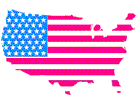Learn about the geography and economy of the Southern colonies/states.
Objectives:
 Students will be able to name the states of the Southern region.
Students will be able to name the states of the Southern region.- Students will be able to describe the geography and climate of the Southern region.
- Students will be able to define the term cash crop and identify cash crops that were important to the economy in the South.
- Students will be able to describe how each of the Southern states was originally established as a colony.
Suggested Grades:
4th Grade – 5th Grade – 6th Grade
Procedure:
- Read lesson or have students read it silently.
- Have students answer the questions on the worksheet.
- Discuss answers to questions.
Lesson Excerpt:
The southern region of the United States contains five of the original thirteen colonies – Maryland, Virginia, North Carolina, South Carolina and Georgia. This region is known as the tidewater region because of the many waterways along its low-lying coast. The climate and soil in the south is suitable for raising crops like cotton, peaches and peanuts. In colonial times, rice, tobacco and indigo (a plant used to produce blue dye) were also important cash crops – crops that can easily be sold. The growing season in the south lasts from seven to eight months, so farming was an important part of life there.
The tidewater forests also offered many opportunities for hunters. The forests were filled with ducks, dear, bears, buffalo and turkeys. There were also many fish to be caught in the rivers of the tidewater region.
Virginia was the first colony in the southern region. Then, in 1632, George Calvert asked the king for an area of land for Catholics. The area became known as the colony of Maryland. By 1640, however, most of the colonists in Maryland were not Catholic. The Carolinas were the next colonies established. First known as one colony called Carolina, this area was a gift from King Charles II to eight of his friends. They named the region Carolina after him (Charles is Carolus in Latin). King George II took over Carolina in 1729 and divided it into two colonies. North Carolina attracted many tobacco farmers from Virginia, while the swampy soil in South Carolina was more suitable for growing rice and indigo.
